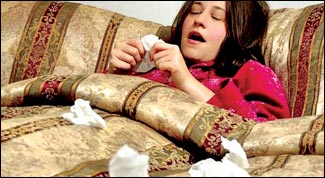|
Health Watch
Somatoform Disorders in children
Dr Ruwan M Jayatunge M.D.
Somatoform Disorders are common among the children due to various
stress factors experienced by them in the contemporary society. Today
the children face numerous kinds of stresses at home and school.
Following the overwhelming stress and unresolved mental conflicts,
Somatoform Disorders can be seen among the vulnerable groups. On most
occasions, these ailments are not properly assessed or treated.
Therefore, Somatoform Disorders can affect the child for a long period.
sometimes until the adulthood.
|

Pretending to be sick |
The Somatoform Disorders are a group of mental problems characterized
by physical complaints without any physical disease or condition. As a
group, the somatoform disorders are difficult to recognize and treat
because patients often have long histories of medical treatment with
several different doctors.
In addition, the physical symptoms are not under the patientís
conscious control. Somatoform disorders are usually co-morbidity with
other psychological disorders, particularly mood or anxiety disorders.
Stress is believed to be one of the most common causes of somatoform
disorders in children. Many stresses and anxieties affect children. For
instance exam stress, sibling rivalry, parental separation etc can cause
psychological degradation in children.
According to the DSM 4 Somatoform Disorders are classified as:
1) Somaization Disorder
2)Undifferentiated Somatoform Disorder
3) Conversion Disorder
4) Pain Disorder
5) Hypochondriasis
6) Body dysmorphic Disorder
7) Somatoform Disorder not otherwise specifiedSomaization Disorder
Children with Somaization Disorder chronically and persistently
complain of varied physical symptoms that have no identifiable physical
origin. One common general explanation of genesis of Somaization
Disorder is that the internal psychological conflicts are unconsciously
expressed as physical signs. Such symptoms cannot be related to any
medical condition. The symptoms do not all have to be occurring at the
same time, but may occur over the course of thedisorder.
Story of Miss G
Miss G- a young girl child who had special talents in music. She was
praised by the parents and peers for her magnificent performances in
music. Miss G anticipated good results in the music exam and wanted to
further her education in music. Her talents and self-confidence faded
gradually when the newly appointed music teacher of her school made
sarcastic remarks over her performance. The teacher was highly critical
of Miss G. As a result of the personal conflict Miss G did not like to
attain the music classes and she was worried about the exam.
|

Feeling insecure |
After a few weeks, Miss G experienced severe abdominal pain and loss
of energy and tremors in both hands. She could not play the musical
instruments anymore. Her parents took her to various physicians for the
medical management and no specific diagnosis was established. Despite
the analgesics, she experienced the pain for a log period. Eventually
her mental worry was revealed and resolved via counselling. The teacher
was advised to have a sympathetic attitude towards her. With the change
of stressful environment, Miss G s condition improvedrapidly. She was
able to pass her music exam with an excellent credit.Conversion disorder
Conversion disorder, once referred to as hysteria, is thought to be
caused by mental factors, such as stress and conflict. Children with
Conversion disorder experience as (convert into) physical symptoms. In
conversion disorder, physical symptoms that resemble those of a
neurological disorder develop.
The symptoms are triggered by mental factors such as conflicts or
other stresses. An arm or leg may be paralyzed, or children may lose
their sense of touch, sight, or hearing. Many physical examinations and
tests are usually done to make sure symptoms do not result from a
physical disorder. Often, symptoms begin after some distressing social
or psychological event.
Master N was a 12 y old schoolboy who was troubled by the parental
conflicts. His father who consumed alcohol heavily often assaulted the
mother. When the father goes in to tantrums, Master N becomes uneasy and
helpless. One day when the father tried to attack the motherMaster N
intervened and he too was beaten by the father. Following the physical
beatings Master N could not walk. Then he was rushed to the hospital.
The doctors found no internal injury that could have caused the
paralysis of the lower limbs.
Notwithstanding the treatment over 4 weeks, Master N s condition did
not improve. Although the Neurological investigations showed no
pathology, Master N still exhibited the symptoms of paralysis. After the
psychological mode of management and family counseling he was assured
that the family violence would not occur anymore. Following the fatherís
positive change, Master N regained his walking ability.Hypochondriasis
in young children
Hypochondriasis is characterized by unexplained physical symptoms
that can be directly related to fear that other person has contracting
disease (disease conviction) or fear that he may acquire those
identified disease (disease phobia).
Miss NB was a 16-year-old girl who looked after her aging
grandmother. Her grandmother was diagnosed with throat cancer and Miss
NB saw her prolonged suffering. While nursing her enfeeble grandmother,
Miss NB had an unexplainable fear of contaminating the disease. After
the Granny passed away, Miss NB had difficulty of swallowing food and
experienced pain. Her parents immediately took her for medical treatment
and further investigations. All the investigations concur that Miss NB
had no apparent illness but her marked anxiety wasdetected.
She strongly believed that she too was getting the throat cancer like
the grandmother. Her irrational fear was challenged under the friendly
mediation and ultimately she was able to gain the insight. Today she is
free of symptoms and continues her university education.Pain disorder
Pain disorder, it is termed when a patient complains severe focused
pain that cannot be attributed or relate the pain to specific medical
disorder and cannot be relieved by analgesic.
A large number of children are affected by pain disorder following
school phobia and exam phobia. Children affected by pain disorder
genuinely feel the painful sensations. Therefore punishing or
threatening the child could aggravate the condition.
Body Dysmorphic Disorder
Body Dysmorphic Disorder is another form of somatoform disorder in
which a patient think that he or she has a defect in his or her body
well in fact there is none; this can further be associated to
unsuccessful attempts to correct the patientís image, through undergoing
series of cosmetic surgery. Many teenagers feel that their body images
are not attractive and have a low self-esteem and negative self-picture.
In some children this negative thinking pattern becomesan over valued
idea leading to overwhelming stressful reactions.
|

Feeling left out |
Master U a teenager troubled by severe sibling rivalry strongly
believed that his nose was out of shape. He became furious if anyone
made humorous comments on his facial appearance. Although there was no
significant repulsive appearance, he was avoiding social situationsand
preoccupied with correcting the nose via finger manipulation. He thought
that his elder brother is more attractive then him.
On the contrary, there was no much of a difference between the
anatomical shapes of the noses in two brothers.
Still Master U believed that he was ugly and wanted to go for a
cosmetic surgery. Prier to the surgery he was referred for psychological
support service and treated with psychotherapy to overcome the
difficulty. After series of psychological interventions, Master U gave
up the cosmetic surgery and realized that he had no anatomical
defect.Specific interventions in somatoform disorders. Children with
Somatoform Disorders have long history of stress and anxiety. They need
counselling and psychotherapy to regain the life balance. Psychotherapy
focuses on the unconscious and believes it influences human behaviour.
Repressed conflicts from childhood lead to personality problems later in
life. Anxiety is a direct result of the repression of conflicts
Psychotherapist believes that the unconscious motives along with
unresolved conflicts lead to maladapted behaviour.
Psycho education can also be useful tool to that explains a stress or
any emotional distress can be factors for having physical symptoms.
Sometimes drug treatments are needed to address the emotional
disturbances and comorbid psychiatric symptoms.
Client Centered therapy can be used positively to treat children with
somatoform disorders. Client Centered therapy gives more responsibility
to the child in their own treatment and views his difficulty in a
positive manner. The therapist will move the client towards
self-awareness, helping the client to experience previously denied
feelings.
They will teach the client to trust in himself or herself and to use
this trust to find their direction in life. The person-centered
therapist makes the client aware of their problems and then guilds them
to a means of resolve them.
Relaxation, biofeedback and stress management is a great help in
decreasing the
emotional and bodily arousal. Relaxation therapies drastically reduce
anxiety attacks connected with somatoform disorders.
Behaviour therapy highlights that the abnormal behaviour is a direct
result of defective learning. This may include assertion, behavioral
rehearsal, coaching, cognitive restructuring, desensitization, modeling,
reinforcement, relaxation methods, self-management, or new social skills
to combat the ill effects of somatoform disorders.
Cognitive Behaviour Therapies are often used to treat children with
somatoform disorders. The goal of treatment is to help the person learn
to control the symptoms.
Hypnosis may help by enabling people to control how stress and other
mental states affect their bodily functions. A certified clinician must
conduct hypnotic therapy.
Rational-emotive therapy is a highly action-oriented and deals with
the clientís cognitive and moral state. This therapy stresses the
clientís ability of thinking on their own and in their ability to
change. Rational-emotive therapy challenges the clientís irrational
thinking that is connected with the somatoform features.
Newly introduced and internationally recognized therapeutic mode -
EMDR or eye movement desensitization and reprocessing effective in
treating children with somatoform disorders. Research suggests that EMDR
is equally powerful as Cognitive Behaviour Therapy.Special Tips for
Parents
1) Listen to the child when he/she complains of unusual symptoms
2) Do not punish or humiliate the child
3) Try to find the underline cause
4) Talk to the teachers and find out any school related problems
troubling the child
5) Get medical opinion from a recognized medical practitioner
6) When seeking counselling and psychotherapy get advice from a
Psychiatrist / Psychologist attached to a Government Hospital.
NIROGI Lanka - timely intervention
Fathima Razik
Not surprisingly, Diabetes, a non communicable disease, has been
cause for concern amongst medical professionals over a period of time in
view of the increasingly large number of patients who seem to be
afflicted with this disease that has to be endured as there is no known
permanent cure.
Thus the National Initiative To Reinforce And Organise General
Diabetes Care In Sri Lanka (NIROGI LANKA) was launched under the aegis
of the Ministry of Health in collaboration with all stakeholders in
managing diabetes under the purview of the Diabetes Prevention Task
Force (DPTF) of the Sri Lanka Medical Association (SLMA). The Ministry
of Health has recognised the need to target chronic Non Communicable
Diseases (NCD), in particular, the rapidly increasing number of
diabetics from the lower socio-economic groups in the country.
With a grant from the World Diabetes Foundation (WDF) three specific
areas of activity have been mapped out that would be implemented through
the existing health care delivery systems underscored by the expertise
and experience of the DPTF so as to ensure the smooth running of each
activity, concurrently. DPTF has as its mandate and objectives, to
stimulate and support the adoption of effective measures for the
surveillance, prevention and control of Diabetes Mellitus in Sri Lanka
combined with the prevention of Cardiovascular Diseases.
The three major components of NIROGI LANKA are:
(a) National program for capacity building in diabetes care by
establishing a pioneer cohort of diabetes nurse educators initially for
the state health sector, to be expanded later to selected private
primary care services through the College of General Practitioners of
Sri Lanka.
(b) Improving quality of diabetes care through the development of a
health care model of tertiary-primary care partnership to be initiated
in the city of Colombo - i.e. to provide quality care close to the homes
of the affected persons
(c) Prevent Type 2 Diabetes by empowering the public through
activities that encourage community and family participation in a
defined area of the suburban areas of Colombo.
Since its launch in mid 2009, the team behind this worthy project has
had a series of regular meetings with the main stakeholders - the
Medical Officers of Health, the Education Officer (Colombo district) and
the Head of the Department of Community Medicine to co-opt Health
Promotion Facilitators (HPF) in the Kotte and Kolonnawa areas where the
pilot project was conducted. Health Promotion Facilitators would be
trained in all relevant areas of work they would engage in to create the
necessary awareness to stem the spread of the disease and to assist
those affected to seek treatment, adopt the correct lifestyle and take
prevention measures so as to prevent a further deterioration of their
health.
The initial workshop conducted for HPF was under the guidance of an
expert team from the Department of Health Promotion, University of
Rajarata, turned out to be a success with 100% participation of the
identified HPFís and the feed back received, thereafter. It included
training in health promotion, recruiting target groups and establishing
a Health Information System (HIS). Consequently, the meeting with the
Department of Computing, University of Colombo, to set up a HIS was held
which would facilitate health promotional activities within communities,
schools and work places.
The project went on to target for screening the adult population in
slum areas who are in real need of such services.
The laboratories of the Colombo Municipal Council (CMC) located in
five localities within the city have the capacity to screen 1000 adults
per month in addition to the approximately 2000 diabetics who are tested
at its clinics every month.
The Ministry of Healthcare and Nutrition supplies the drugs and
consumables for the project.
As the project progressed a major achievement was the developing of a
national program for capacity building in diabetes care through which a
pioneer cohort of Diabetes Nurse Educators was established and who
through their acquired skills will practice in the state sector
hospitals in the Western Province and Teaching Hospitals in Sri Lanka.
Medical professionals from various hospitals and institutions from
many parts of the island along with the other partners in this venture
have for the past nearly eight months worked very hard to implement this
program that is aimed at stemming a disease that has turned out to be
slow and silent killer, that once it sets in, will remain so within a
personís system, taking its time bring on much suffering as it gradually
progresses.
Project Chairperson, Professor Chandrika Wijeyaratne, in response to
a question on the status of the program expressed satisfaction at the
manner in which targets and time lines are met, and added that this was
possible due to the unstinted support and cooperation extended by all
involved which also ensures that the first ever World Diabetes
Foundation funded project is a success.
If so, the country would be one that has through its committed and
devoted medical professionals, addressed an issue that otherwise would
have been blown out of proportion, and too late to prevent an
unfathomable number of diabetics in Sri Lanka.
Prevention is certainly better than cure. Only in this instance there
is no cure. It is therefore up to each individual to keep a check on
their own health and that of their near and dear ones. The well known
proverb comes to mind - Health is better than wealth. |



